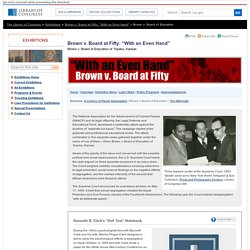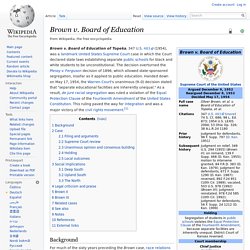

Brown v. Board of Education of Topeka, Kansas - Brown v. Board at Fifty: "With an Even Hand" Three lawyers confer at the Supreme Court, 1953.

Gelatin silver print. New York World-Telegram & Sun Collection, Prints and Photographs Division, Library of Congress (98) The National Association for the Advancement of Colored People (NAACP) and its legal offspring, the Legal Defense and Educational Fund, developed a systematic attack against the doctrine of “separate but equal.” The campaign started at the graduate and professional educational levels. The attack culminated in five separate cases gathered together under the name of one of them—Oliver Brown v.
Aware of the gravity of the issue and concerned with the possible political and social repercussions, the U.S. The Supreme Court announced its unanimous decision on May 17, 1954. Discover! Kenneth B. During the 1940s, psychologists Kenneth Bancroft Clark and his wife, Mamie Phipps Clark designed a test to study the psychological effects of segregation on black children. Enlarge Dr. Reading Lesson in Washington, D.C. Kenneth B. Annotation. Brown v. Board of Education. Educational segregation in the US prior to Brown §Background For much of the sixty years preceding the Brown case, race relations in the U.S. had been dominated by racial segregation.

This policy had been endorsed in 1896 by the United States Supreme Court case of Plessy v. Ferguson, which held that as long as the separate facilities for the separate races were equal, segregation did not violate the Fourteenth Amendment ("no State shall... deny to any person... the equal protection of the laws. "). The plaintiffs in Brown asserted that this system of racial separation, while masquerading as providing separate but equal treatment of both white and black Americans, instead perpetuated inferior accommodations, services, and treatment for black Americans.
§Case §Filing and arguments In 1951, a class action suit was filed against the Board of Education of the City of Topeka, Kansas in the United States District Court for the District of Kansas. The Kansas case, "Oliver Brown et al. v. §Holding. Annotation. Brown v. Board. What was the result? Brown v. Board of Education. Brown versus Board of Education (1954) (full name Oliver Brown, et al v.

Board of Education of Topeka, Kansas) was an important law case in the United States. This case was decided by the Supreme Court of the United States, which is the highest court in the US. In Topeka, Kansas, a black third-grade girl, named Linda Brown had to walk more than a mile through a railroad switchyard to get to her black school, even though there was a white elementary school less than seven blocks away. Her father tried to get her into the white school, but the principal of the school refused. Twelve more black parents joined Oliver Brown, Linda’s father, in trying to get their children into the white elementary school. The Ruling[change | edit source] The Supreme Court has nine justices.
Other websites[change | edit source] These links may not be in simple English: Who was Involved in brown v. board of education? Brown v. Board of Educaton : African American Sites (Virtual Programs & Services, Library of Congress) Was the problem ever solved ??